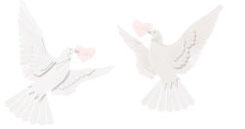DreamWeddingPlanner

Wedding Planning Guide -
Our Wedding Planner Contains TONS of resources to plan the perfect wedding! Bookmark Us
DreamWeddingPlanner.com
 |
| Wedding Planner | Wedding Planning Basics | Wedding Planner Articles | Wedding Favors | Top Wedding Products | Wedding FAQ & Advice | Wedding Planning Forum |
Wedding Planning Guide - |
|
Proud to be sponsored by the #1 wedding
planner eBook to plan your dream wedding on the net! Our Wedding Planner Contains TONS of resources to plan the perfect wedding! Bookmark Us |
|
|
Jewish Wedding Traditions - The Wedding Day in a Nutshell By Josh Singer Many of the Jewish wedding traditions are derived from ancient Jewish wedding customs dating back thousands of years. Orthodox Jewish weddings always include these customs. Conservative, Reform, and Reconstructionist Jews and others can gather meaningful Jewish Wedding traditions from these pages to incorporate into their wedding day. In traditional circles, both the bride and groom do not see each other for a week before the wedding. They then both fast on the wedding day, unless it falls on the day of the new Jewish month. Pre-Chuppah (Jewish Wedding Canopy) Festivities The wedding itself begins with the groom's ketubah signing. The ketubah is the Jewish marriage contract that acknowledges the commitment and obligations the bride and groom have toward each other. While this is happening, the bride sits like royalty in a separate area and greets all of the wedding guests. This is called Kabbalat Panim--where Hors d'Ouevres are often served. After the groom signs the Ketubah, the crowd dances him to his bride for an ancient jewish wedding tradition called the Bedekin. The bedekin is where the groom lowers the veil over the bride's face. The reason for this Jewish wedding tradition comes from the Old Testament. In the old testament of the bible, Jacob was fooled while trying to marry Rachel, and instead was married to a woman named Leah who was completely veiled before and during the ceremony. Jewish grooms today do this tradition to symbolically acknowledge that the bride is indeed one's beloved. The guests are then escorted to the main hall for the wedding ceremony. The Jewish Wedding Traditions of the Ceremony While the groom is being escorted to the chuppah, the bride sits in meditative prayer. This is a wonderful Jewish wedding tradition that allows the bride to reflect on both her single life that is ending and her married life that is beginning. The rest of the wedding attendants walk down to the chuppah and await the bride's entrance. Her parents walk her down and when she reaches the groom she engages in the ancient jewish wedding tradition where she circles her groom three or seven times, symbolizing the "new family circle" she is creating with him. The rabbi then welcomes the guests and invokes the blessing of G-d. The rabbi or cantor then recites the kiddush, the blessing over a cup of wine, and the couple responds, Amen. The couple then drinks from the cup of wine. The groom then takes a Jewish Wedding ring and gives it to the bride, while reciting the marriage betrothal statement in both Hebrew and English, "With this ring, you are consecrated to me in according to the laws of Moses and Israel." In Orthodox weddings, there is only one ring, from groom to bride, signifying the groom's commitment to the bride with a valuable object. After the bride accepts the ring, the rabbi or an honoree reads the ketubah for all to hear, and then hands it to the groom, who in turn hands it to the bride. Generally, this is when the rabbi makes a short speech. Afterwards, the rabbi or an honoree(s) recite the sheva b'rakhot, or seven jewish wedding blessings, which praise G-d and wish the couple blessing in their new life. Finally, the best-known traditions of Jewish weddings occurs-- the breaking of the wedding glass. After the Chuppah Jewish Wedding Traditions The breaking of the glass ends the actual ceremony. The crowd then dances the couple to a private room, where they spend 10-15 minutes alone, time to exhale and embrace. In addition, they break their fast together, and in addition to digesting food, they have a moment to digest what has taken place. The bride and groom then enter the dining hall for the first time as a married couple and the festivities begin. Like any wedding, there is dancing, music, good food, and lots of booze. :) An honoree(s) says the blessing over the bread, and the grand meal begins. After Birkat Hamazon-- the grace after meals-- is said, the Sheva B'rakhot are repeated. Of course, this guide is a brief overview of all the intricate Jewish wedding traditions and customs found in Jewish Weddings. |
Learn the secrets to planning the wedding of your dreams. You'll be amazed with the beauty and ease of having the wedding of your dreams without the extra costs of hiring a Wedding Planner. Find out how we saved money and attained our fairytale wedding! Click here to learn the secrets. |
||
| Send me an email. I would love to hear your suggestions for the wedding planner site! Wedding
Planner | Wedding
Planner Tips | Wedding Planner
Guide | Contact |
||||